Hino-cho, Shiga: Difference between revisions
No edit summary |
No edit summary |
||
| Line 57: | Line 57: | ||
'''Hino-cho''' (日野町; Hino-chō) is a town in southeastern [[Shiga Prefecture]]. | '''Hino-cho''' (日野町; Hino-chō) is a town in southeastern [[Shiga Prefecture]]. | ||
'''Famous for:''' | |||
*Omi Hino merchants and their grand homes forming traditional townscapes. | |||
*Hino Matsuri of ornate festival floats on May 2–3. | |||
*Shakunage Valley of Rhododendron flowers blooming in early May. | |||
In area, Hino is one of the largest towns in Shiga. Although it is landlocked, surrounded by much larger cities, and serviced by only one train station, Hino can well hold its own with major festivals such as the Hino Matsuri in early May and major sightseeing attractions. The town is quiet and rural, and certain areas are noted for traditional townscapes. | In area, Hino is one of the largest towns in Shiga. Although it is landlocked, surrounded by much larger cities, and serviced by only one train station, Hino can well hold its own with major festivals such as the Hino Matsuri in early May and major sightseeing attractions. The town is quiet and rural, and certain areas are noted for traditional townscapes. | ||
Revision as of 09:20, 12 November 2022
| Hino, Shiga (日野町; Hino-chō) | ||
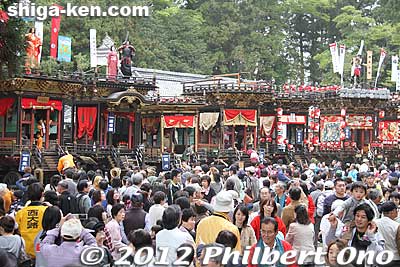 Hino Matsuri on May 3. More Hino photos here. Hino Matsuri on May 3. More Hino photos here.
| ||
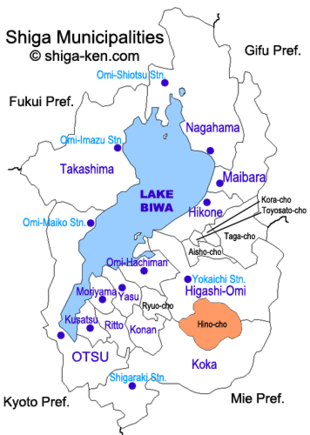
| ||
| Google Map of Hino here. | ||
| Location | Shiga Prefecture, Kinki region, Honshu island, JAPAN | |
| Population | 21,156 (?? foreigners) (2022-01-01) | |
| Area | 117.62 km² | |
| Town Centers | Okubo 大窪 | |
| Major Sights | Hino Matsuri Festival, Umamioka Watamuki Shrine, Omi Hino Merchant Museum, Rhododendron Valley, Mt. Watamuki | |
| Major Gateways | Hino Station, Omi-Hachiman Station bus terminal | |
| Train Stations | Hino Station | |
| Claim to Fame | Omi Hino merchants, part of Suzuka Quasi-National Park | |
| Products | Sake, Hino-na pickles | |
| Neighbors | Higashiomi, Koka | |
| Old Name(s) | Hino-maki | |
| Keywords | Omi Hino shonin, shakunage | |
| Historical Persons | Lord Gamo Ujisato | |
| Links | Hino Articles | Hino Photos | |
| Hino Tourist Information | ||
| Location | 〒529-1604滋賀県蒲生郡日野町村井1284番地(日野まちかど感応館内)
Murai 1284, Hino-cho, Gamo-gun, Shiga-ken 529-1604 | |
| Phone | Tel: 0748-52-6577
Fax: 0748-52-6017 | |
| Tourist Links | Hino-cho Tourism | |
| Int'l Association | Web site | |
| Volunteer Guides | Web site Tel: 0748-52-6577
Fax: 0748-52-6017 | |
| Hino Town Hall 日野町役場 | ||
| Address | 〒529-1698滋賀県蒲生郡日野町河原一丁目1番地
Kawara 1-1, Hino-cho, Gamo-gun, Shiga-ken 529-1698 JAPAN | |
| Phone/Fax | Tel: 0748-52-1211
Fax: 0748-52-2043 | |
| Official Site | Japanese | English | |
| Symbols | Flower: | Rhododendron (Shakunage) |
| Tree: | Hinoki cypress | |
| Bird: | -- | |
| Others: | Hino merchant boy with balance pole | |
| Logo: | ||
| Sister Towns | Embu, Brazil; Eunsan, South Korea; Neustadt an der Aisch, Germany | |
This page is 75% complete. Updated: Nov. 11, 2022
by Philbert Ono
Traditional Merchant Town
Hino-cho (日野町; Hino-chō) is a town in southeastern Shiga Prefecture.
Famous for:
- Omi Hino merchants and their grand homes forming traditional townscapes.
- Hino Matsuri of ornate festival floats on May 2–3.
- Shakunage Valley of Rhododendron flowers blooming in early May.
In area, Hino is one of the largest towns in Shiga. Although it is landlocked, surrounded by much larger cities, and serviced by only one train station, Hino can well hold its own with major festivals such as the Hino Matsuri in early May and major sightseeing attractions. The town is quiet and rural, and certain areas are noted for traditional townscapes.
Hino's history features old castle ruins, Lord Gamo Ujisato who developed the area (before moving to Aizu-Wakamatsu Castle in Fukushima Pref.), and Hino shonin merchants who produced and sold their merchandise all over Japan. A few of their grand, traditional homes can still be seen (and toured) today, such as the Omi Hino Merchant Museum.
Sights
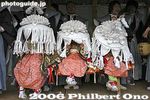
| 
| 
|
| Hino Matsuri | Omi Hino Merchant Museum | Minami Sanno Matsuri |

| 
| 
|
| Umamioka Watamuki Shrine | Omi Hino Merchants | Hifuri Torch Festival |
- Hino Station building 日野駅舎 - Chances are this will be the first building you visit in Hino. The station building was built in 1916, and a century later, it got a major facelift and overhaul. Local residents who opposed the building demolition helped to finance this superb restoration. It now includes a community space housing a cafe and tourist information desk.
- Hino Festival 日野祭 - Held annually during May 2 and 3, the Hino Matsuri is the largest festival in eastern Shiga Pref. In 2006, sixteen ornate Hikiyama floats and three portable shrines were paraded through the streets. It is the spring festival of the Umamioka Watamuki Shrine and one of Shiga's Intangible Cultural Properties. Map
- Umamioka Watamuki Shrine 馬見岡綿向神社 - Hino's most prominent shrine is best known for the Hino Matsuri festival on May 2-3. The shrine was originally atop Mt. Watamuki, Hino's tallest mountain. It was moved to its present location in 796. Later it became Lord Gamou's family shrine and it was revered by Hino merchants during the Edo Period. Map
- Omi Hino Merchant Museum 近江日野商人館 - Hino was home to many Omi merchants who plied up and down Japan during the Edo Period to sell and trade their wares. They became quite successful selling medicines, lacquerware, sake, etc. A museum in a former home of a Hino merchant exhibits artifacts of the Omi Hino merchants carrying their wares on a balance pole. This home of a former Hino merchant was donated to the town which renovated it into this fine museum opened in 1986. The museum is also in an area featuring a traditional townscape. The town has been working to restore old homes. Read this Wall Street Journal article (Nov. 1, 2013) about American Austin Moore and his Japanese wife who renovated their huge home in Hino. Open 9 am to 4 pm. Closed on Mon. and Fri. In Okubo. Download the museum's English pamphlet here. Map
- Omi Hino Shonin Furusato-kan - 近江日野商人ふるさと館 - Former grand residence of Hino merchant and sake brewer Yamanaka Shokichi (旧山中正吉邸) that has been restored to serve as a local museum and community center. It is right on the road leading to the entrance of Umamioka Watamuki Shrine. Out of all the Hino merchant homes open to the public, this is one of the largest and grandest. It was purchased and restored by Hino Town (taking two years) and opened to the public on April 1, 2015. It preserves Hino’s historical and cultural artifacts and serves as a local information center. Open from 9 am to 4 pm, closed on Mondays and Tuesdays (open if a national holiday), the day after a national holiday, and Dec. 29–Jan. 4. Map
- Nakano Castle 中野城跡 - Nakano Castle, also known as Hino Castle (日野城), built in 1534 by Lord Gamou Katahide, father of Ujisato. In 1582, when Oda Nobunaga was assassinated in Kyoto, Katahide evacuated Nobunaga's wife and child from Azuchi Castle to this castle. It was abandoned in 1597. Only a few stone walls and shrines remain adjacent to Hinokawa Dam. Map
- Shingyoin Temple 信楽院 - Graves of the Gamo clan are here. Also known for a painting of a dragon on the ceiling.
- Mt. Watamuki 綿向山 - Hiking trails lead to waterfalls. The peak is part of the Suzuka mountain range, and the elevation is 1,110 meters. Map
- Blumen Hugel ブルーメの丘 - Agricultural theme park, with many flowers like tulips (April-May), rape blossoms (April-May), roses, and sunflowers (summer). Map
- Hino Dahlia Garden 日野ダリア園 - Large flower garden with 150 varieties of dahlia. Also, peonies, clematis, and strawberry picking. Opened in 2002, the garden is operated and maintained by local senior citizens. Strawberry picking/eating from late Feb. to late May. Peonies bloom from late April to late May, and dahlia bloom from early Aug. to late Oct. Open 9 am to 4 pm, closed Tue. (open if national holiday and during peak bloom). Admission 500 yen for adults 200 yen for kids. From Hino Station, take a bus or taxi (10 min.). Map
Event Calendar
- April 4 - Minami Sanno Festival 南山王の祭 - Major festival of colorful flowery streamers called Hoinobori in a park. Spring festival of Hieda Shrine. Map
- Late April to Early May - Rhododendron in bloom at Shakunage Valley or Kaigake-dani しゃくなげ渓/鎌掛谷. A short bus ride from Hino Staion is the valley of Rhododendron flowers which bloom in early May. It is a lush and cool gorge with a river and steep hillsides bearing numerous flower bushes. A very pleasant walk for families. Rhododendron (shakunage) is the town flower. Map
- Early May - Wisteria blooms at Shohoji temple (正法寺), a Zen Buddhist temple. 25-min. bus ride from Hino Station. Map
- May 2-3 - Hino Festival 日野祭. The town's largest festival. The 2nd is a night festival where the floats are lit up. The main festival is held on the 3rd at Umamioka Watamuki Shrine and Hibarino Park. Map
- Aug. 14-15 - Hifuri Torch Festival 火ふり祭. People light their torches at Gosha Shrine and proceed to Hibarino park where the torches are thrown up to a large pine tree. The more torches get stuck on the tree, the better the next harvest will be. Map
- Early June - Many azaleas in bloom at Unkoji temple 雲迎寺 Map
- Sept. 1 - Omi Nakayama Imo-Kurabe Festival 近江中山の芋競べ祭り. Festival comparing the length of yam stems to foretell the year's harvest.
Travel Tips
- There is a tourist information office inside Hino Station and the main tourist info office in Okubo on the main road.
- Except for a cafe and railway museum, there is not much near Hino Station, so take a bus from the station to other parts of Hino.
- The center of town is Okubo, a short bus ride from Hino Station.
- Current weather warnings/advisories for Hino here (Japan Meteorological Agency).
Getting There
By Train
Hino has only one train station, Hino Station on the Ohmi Railways Main Line.
Train Lines & Stations
- Ohmi Railways Main Line (Honsen): Hino Station
Travel Time
- From Tokyo Station to Hino Station: JR Tokaido Shinkansen to Maibara Station (2.5 hours), then transfer to Ohmi Railways for Hino Station (60 min.).
- From Kyoto Station to Hino Station: JR Tokaido Main Line shin-kaisoku to Omi-Hachiman Station (31 min.), then take Ohmi Bus to Hino Station (40 min).
- From Maibara Station to Hino Station: 60 min. via Ohmi Railways
- From Yokaichi Station to Hino Station: 20 min. via Ohmi Railways
- From Kibukawa Station to Hino Station: 20 min. via Ohmi Railways
By Bus
- From Omi-Hachiman Station to Hino Station: 40 min. by Ohmi Bus. Go to the south side of Omi-Hachiman Station and catch the bus bound for Kitahata-guchi 北畑口. Buses leave about once an hour. Bus schedule here.
Nearest Airports
- Kansai International Airport
- Central Japan International Airport (Centrair)
- Osaka International Airport
Getting Around
By train
Train stations in Hino-cho and their places of interest are as follows:
- Hino Station - The only train station in Hino. There is a nice cafe and tourist information desk inside the station building. Trains and buses are infrequent, once an hour during most of the day. Take a bus to central Hino (Okubo) or rent a bicycle in front of the station.
By bus
- Buses available at Hino Station going to the center of town and farther areas. Details in Japanese only.
By bicycle
- Rental bicycles available in front of Hino Station and at the tourist office in central Hino near Okubo. This might be the best way to get around Hino if you want to see most of the sights.
Maps
Placemarks in Google Maps are in English. Click on upper right icon to enlarge.
Photos
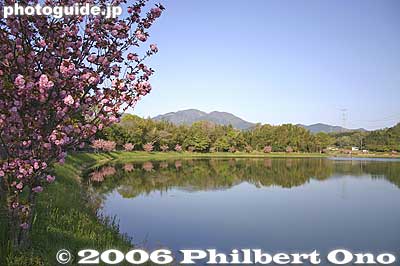
| 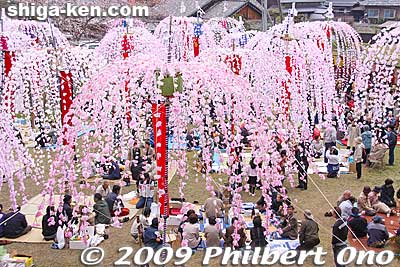
|
| Hinokawa Dam Park | Minami Sanno Matsuri |
More photos at Hino-cho Photos. More Shiga photos here.
Videos
Click on the video image to start playing the video. More Shiga videos here.
Side Trips
Other sights in neighboring cities/towns within easy reach from Hino-cho.
- Higashiomi - Near Yokaichi Station is the Higashi-Omi Kite Museum.
- Minakuchi - Near Minakuchi Jonan Station is Minakuchi Castle.
History
- 1582 - Lord Gamo Ujisato starts to encourage commercial activities in Hino, laying the ground for Hino merchants to prosper.
- 1584 - After victories in battle, Lord Gamo Ujisato is rewarded with a fief in Ise (Mie Pref.) and moves away from Hino. During the Edo Period, Hino merchants prosper by selling mainly medicines and lacquerware.
- 1900 - Ohmi Railways Hino Station opens in Oct.
- 1955 - Six villages merge to form Hino-cho town.
- 2020 - Three-year project to renovate Hino Station is completed.
Additional Reading
- Hino Station revitalized - Feb. 1, 2022
- Omi Hino Shonin Furusato-kan - October 11, 2015
- Miki Ito wins World Cup dual moguls - February 24, 2013
- Hino Hikiyama float signs in English - June 3, 2007
Miscellaneous
Trivia
- Hino-cho is one of the few towns in Shiga which have not merged with any neighboring municipality.
- Aizu-Wakamatsu in Fukushima Prefecture was named after a place in Hino called "Wakamatsu no Mori" 若松の森 by Hino-native Lord Gamo (Gamoh) Ujisato who founded Aizu-Wakamatsu.
- For years, there have been proponents for building an airport (Biwako Airport) in Hino. However, due to stiff local opposition, such talk has been silenced.
Famous People
- Gamo Ujisato (1556-1595) 蒲生氏郷
- Born in Hino, and became Lord of Gamo region which includes Hino town. Served under Oda Nobunaga and Toyotomi Hideyoshi. Married Nobunaga's second daughter Fuyuhime at age 14. Revered for developing Hino to enable Hino merchants to prosper. Later became lord of Wakamatsu (Tsurugajo ) Castle in Aizu-Wakamatsu which he founded and developed in Fukushima Prefecture. He named the town Wakamatsu, after a place called Wakamatsu no Mori in Hino. He is revered in Aizu-Wakamatsu as well. Died suddenly at age 40. One theory says that he was poisoned by Toyotomi Hideyoshi. Ujisato was also a Christian lord, so it is ironic that he is buried at a Buddhist temple in Kyoto and Aizu-Wakamatsu.
- Ito Miki 伊藤みき (1987- )
- Freestyle moguls skier who represented Japan at the Torino Winter Olympics in 2006, the Vancouver Winter Olympics in 2010, and Sochi Winter Olympics in 2014 when an injury prevented her from competing.
Related Articles
- Shiga Prefecture
- Shiga Prefecture Sights
- Shiga Prefecture Transportation
- Shiga Prefecture Municipalities
External Links
- Umamioka Watamuki Shrine Official site
- Hino Matsuri - Guide to the festival in Japanese.
| Municipalities of Shiga Prefecture 滋賀県 | ||
| Cities & Towns: Aisho-cho | Higashi-Omi | Hikone | Hino-cho | Koka | Konan | Kora-cho | Kusatsu | Maibara | Moriyama | Nagahama | Omi-Hachiman | Otsu | Ritto | Ryuo-cho | Taga-cho | Takashima | Toyosato-cho | Yasu | ||
| 愛荘町 | 東近江市 | 彦根市 | 日野町 | 甲賀市 | 湖南市 | 甲良町 | 草津市 | 米原市 | 守山市 | 長浜市 | 近江八幡市 | 大津市 | 栗東市 | 竜王町 | 多賀町 | 高島市 | 豊郷町 | 野洲市 | ||
| Prefectures of Japan | ||
| Aichi | Akita | Aomori | Chiba | Ehime | Fukui | Fukuoka | Fukushima | Gifu | Gunma | Hiroshima | Hokkaido | Hyogo | Ibaraki | Ishikawa | Iwate | Kagawa | Kagoshima | Kanagawa | Kochi | Kumamoto | Kyoto | Mie | Miyagi | Miyazaki | Nagano | Nagasaki | Nara | Niigata | Oita | Okayama | Okinawa | Osaka | Saga | Saitama | Shiga | Shimane | Shizuoka | Tochigi | Tokushima | Tokyo | Tottori | Toyama | Wakayama | Yamagata | Yamaguchi | Yamanashi | ||